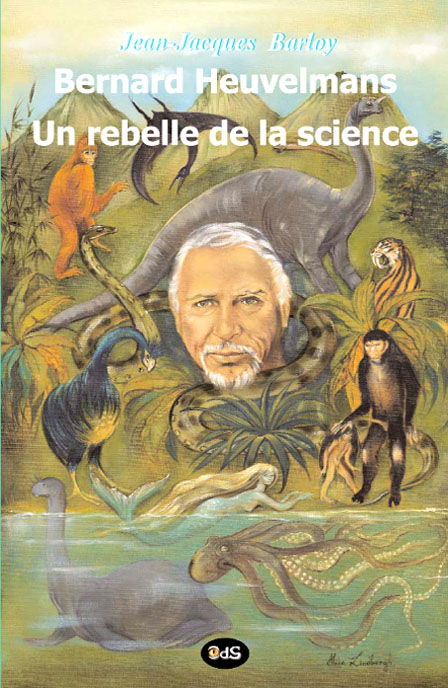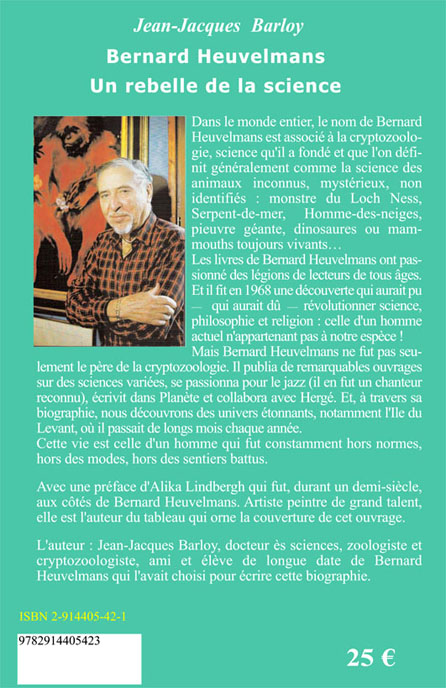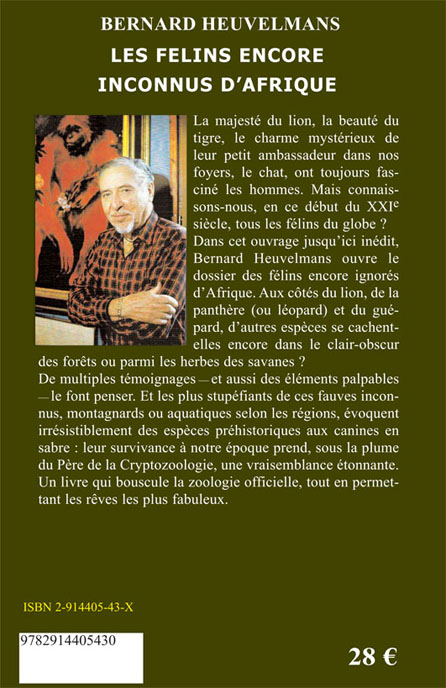New Bernard Heuvelmans Books
Posted by: Loren Coleman on June 2nd, 2007
Breaking news is announced today of two important volumes.
The publisher Eye of the Sphinx has just announced the first two books of and by Bernard Heuvelmans that are to be published in June 2007. This is in a projected series of French books that promises to publish several of Heuvelmans’ works. The first is a biography, Bernard Heuvelmans: A Rebel of Science by Jean Jacques Barloy, and the other is The Still Unknown Felines of Africa by Bernard Heuvelmans.




The official price is said to be 25 and 28 euros.
Here is the table of contents for the two books:
Bernard Heuvelmans, un rebelle de la science – Jean Jacques Barloy
Préface par Alika Lindbergh………………………………………………………………………………11
Avant-propos…………………………………………………………………………………………………17
I. Entre falaises et dunes……………………………………………………………………………………19
II. Un prince de la Renaissance…………………………………………………………………………..29
III. Une fée et un paradis…………………………………………………………………………………..47
IV. Le coup de tonnerre de 1955……………………………………………………………………….59
V. Le Serpent-de-mer démasqué………………………………………………………………………..81
VI. Saveurs africaines 87
VII. A portée de la main : la découverte du siècle…………………………………………………..93
VIII. Un ermitage en Périgord…………………………………………………………………………..109
IX. Entre honneurs et amertume………………………………………………………………………..119
X. Le tort d’avoir eu raison trop tôt…………………………………………………………………..139
Postface par Benoit Grison………………………………………………………………………………143
Annexes
1/ Journaux et revues auxquels Bernard Heuvelmans a collaboré……………………………..151
2/ Espèces nommées scientifiquement par Bernard Heuvelmans………………………………153
3/ Article de Voilà, juillet 1944, consacré à Bernard Heuvelmans…………………………….155
4/ Extraits de la fameuse lettre du 18 décembre 1968 envoyée à Alika Lindbergh au mo—
ment même de l’examen du spécimen et les deux courriers adressés par Bernard Heuvel—
mans à Jean-Jacques Barloy sur l’homme pongoïde en 1969 et 1970………………………157
5/ Un livre important La vie fantastique des animaux par Bernard Heuvelmans…………..165
6/ Peinture L’exposition Alika Lindbergh ou le réalisme onirique par Bernard Heuvelmans 167
7/ Les monstres ou la métamorphosedes animaux inconnus en bêtes fabuleuses et
des bêtes fabuleuses en animaux connus par Bernard Heuvelmans…………………………..169
8/ Bibliographie de Bernard Heuvelmans, établie par Fabrice Tortey……………………….183
Index…………………………………………………………………………………………………………..195
++
Les félins encore inconnus d’Afrique – Bernard Heuvelmans
REMERCIEMENTS
PREMIÈRE PARTIE
DU CONNU À L’INCONNU
CHAPITRE PREMIER — DES FÉLINS PAS COMME LES AUTRES…………………….15
Notre plan de campagne. — Les Abyssins : Wobo, Abu Sotân et Abasambo. — Au Soudan : Nyokodoing, un fauve des marais. — A l’Ouest : lions noirs, tigres et géants. — Bung-Bung : le lion forestier du Cameroun. — Foulempou, l’Absalon congolais. — Bakanga et Ikimizi : les lions-léopards. — L’Entarargo, Ruturargo ou Kitalargo. — Un peu de linguistique comparée. — Les gargouillements du Ntarago. — Intervention inopportune de l’Hyène géante. — Un félin peut en cacher un autre.
CHAPITRE II. — D’AUTRES FÉLINS PLUS EXTRAORDINAIRES ENCORE ……..33
A l’Est : lions-léopards et mélanges plus complexes encore. — Au Sud-Est : tueurs rayés et terreur blanche. — Au Sud : guépards tigrés et razzias insolentes. — Le Khadumadumo est-il le coupable ? — La réalité dépasse la mystification. — Les lions blancs de Timbavati. — Il y a blanc et blanc. — L’albinisme : un gène qui rend trop blanc. — Les mirages de l’individualisme.
CHAPITRE III. — CES GRANDS CHATS SI MAL NOMMÉS ………………………………47
Les guépards, vrais et faux. — Le lion, le pard et le pardalis des Anciens. — Les deux pardalis et le leo pardalis. — Qu’était donc la panthère d’autrefois ? — Naissance du léopard. — Les bâtards présumés et leur dénomination. — Le baptême des hybrides véritables. — Félin nouveau ou bâtard incongru ? — Bâtards encore plus incongrus ou mutation naissante ? — Léopons à gogo, mais point de liopard.
CHAPITRE IV. — MULTIPLICATION DES FÉLINS MAIS AUSSI DES MÉPRISES……67
A propos de lynx : le doigt dans l’œil. — M. de Buffon s’est trompé de serval. — Le « chat-tigre » de Berbérie. — Ne pas confondre serval et caracal. — Chats, chats, chats ! — Pourtant indésirables en Afrique : l’Once et le Tigre. — Dans les ténèbres du « Siècle des lumières » — Le dernier recensement des Félidés d’Afrique. — Reste-t-il encore des félins inconnus ?
DEUXIÈME PARTIE
DE L’AFFAIRE LA MIEUX RÉSOLUE
À LA PLUS OBSCURE
CHAPITRE V. — LE GUÉPARD TIGRÉ D’AFRIQUE AUSTRALE………………………. 87
Le Nsui-Fisi ou léopard hyène : un hybride ? — Pocock : c’est un léopard aberrant. — Cooper : c’est une espèce encore inconnue. — Convaincu, Pocock baptise le Guépard-roi. — Forme spécialisée ou forme primitive ? — La légitimité du monarque mise en doute — Le Guépard royal discrètement découronné — Des peaux royales transformées en manteau — Les rêves de Paul et Lena Bottriell — Les succès de la King Cheetah Expedition — Alors ? Espèce, hybride ou simple anomalie ? — La vérité, toute la vérité et rien que la vérité — Un don du Ciel : deux naissances princières — L’évolution, surprise en pleine action.
CHAPITRE VI. — LE LION TACHETÉ DU KENYA…………………………………………… 109
Deux peaux d’aspect ahurissant. — Gandar Dower s’en va-t-en guerre. — Etre tacheté ou l’être resté, c’est la question. — Le système du rouleau compresseur. — Un point de vue africain. — L’opinion du chasseur blanc Raymond Hook. — L’analyse scientifique de Reginald Pocock. — Retour à la tache originelle.
CHAPITRE VII. — L’ÉNIGME DU « MAROZI »……………………………………………….. 125
Ironie de la presse, mais intérêt des experts. — Le combat cesse faute de combattants. — Le précieux témoignage de Mr Hamilton-Snowball. — Du pour et du contre. — Le réquisitoire du major Foran profite à la défense. — Le bon sens du major White. — Combien existe-t-il de races de lion ? — Le problème ne se limite pas au Kenya. — Une race nouvelle apparemment valide. — Une enquête personnelle sur les lieux. — Et s’il s’agissait d’hybrides ?
CHAPITRE VIII. — « MNGWA », LA BÊTE ÉTRANGE DE TANZANIE………………155
La légende du sultan Magnún. — Le Nunda s’en prend à la Police. — Le témoignage de deux grands experts. — Les arguments du capitaine Hichens. — Le Mngwa ne serait-il pas un chat doré agrandi ? — Des chats dorés peuvent-ils être coupables ?
TROISIÈME PARTIE
LA SURPRENANTE SURVIVANCE DES FAUVES
À DENTS EN SABRE
CHAPITRE IX. — Un reptile équivoque à défenses de morse………………………………….169
Un monstre peut en cacher un autre. — Un animal aquatique à défenses recourbées. — John Alfred Jordan, un Lawrence du Kenya. — Le Dingonek du fleuve Migori. — Évocation intempestive du Lukwata. — L’Ol-umaina du Mara et le Ndamathia du Tana. — Le Dingonek tenu pour un dinosaure. — Le récit personnel de Jordan. — Le Dingonek dans la presse et l’Histoire. — Ce ne peut être qu’un mammifère. — Il doit s’agir d’un félin à dents en sabre. — Des Machairodontes écailleux et aquatiques ? — Confusion avec le Pangolin géant. — Le pourquoi des écailles incongrues.
CHAPITRE X. — INCULPATION DES MACHAIRODONTES……………………………189
Le mystère des hippos manquants. — Le tueur d’hippopotame du lac Bangouélo. — Le Coje ya menia du haut Cuango. — L’enquête de Frau von Nolde. — Le Dr Krumbiegel sur la piste du « Lion d’eau ». — Serait-ce un Tigre à dents en sabre ? — Ou serait-ce un grand reptile ? — Les Machairodontes ont vécu en Afrique. — Le Ntambue ya maï du Kassaï. — Le Ntambo wa luy de la Luembé et consorts. — Le Nzéfu-loï du Lualaba. — L’identité du principal suspect.
CHAPITRE XI. — DENTS LONGUES ET PATTES DE VELOURS……………………… 209
Un lion capable de tuer les éléphants ? — Le Dilali des Baya, Mourou-ngou des Banda, Mamaïmé des Zandé. — L’enquête de l’Inspecteur (des chasses) Blancou. — La « Panthère d’eau » s’attaque même aux hommes. — Le Vassoko, félin montagnard à dents en sabre. — Intermède soudanais : le fauve à crocs longs des Acoli. — Le Hadjel des Hadjeray du Tchad. — Retour à la « Panthère d’eau » de République centrafricaine. — Les deux rencontres du guide de chasse Le Noël. — Du « Tigre de montagne » youlou à la « Panthère d’eau ». — Deux types de félins à dents longues. — Un lion d’eau et un lion des cavernes dans l’Ouest ? — Le N’yamalé des Orungu du Gabon. — L’hippopotame sabré et percé de Maurice Halley. — Des suspects à éliminer. — Le duel à mort des chevaux du fleuve. — Le coupable est enfin démasqué.
CHAPITRE XII. — PORTRAIT DES TUEUR……………………………………………………….233
Prospérité et longévité des Dents-en-sabre. — Des armes encombrantes et fragiles ? — De l’assassinat considéré comme un des beaux-arts. — A chacun sa botte fatale. — Spadassins et traîneurs de sabres. — Niches à occuper : choix limité. — L’Empire des Dents-longues. — Ceux des eaux et ceux des montagnes. — Pas si terribles que ça … — Des armes parfois dissimulées dans une gaine. — Un empire peut-être plus étendu, mais en déclin. — Une admirable adaptation à la vie aquatique. — Des émules d’eau douce du Morse. — Des montagnards nocturnes comparables à l’Ours. — Un portrait bochiman du Machairodonte d’eau. — La preuve par neuf.
LES FÉLINS MYSTÉRIEUX D’AMÉRIQUE DU SUD par Jean-Jacques Barloy……….255
BIBLIOGRAPHIE……………………………………………………………………………………………..257
INDEX…………………………………………………………………………………………………………….281
TABLE DES MATIÈRES……………………………………………………………………………………287
About Loren Coleman
Loren Coleman is one of the world’s leading cryptozoologists, some say “the” leading living cryptozoologist. Certainly, he is acknowledged as the current living American researcher and writer who has most popularized cryptozoology in the late 20th and early 21st centuries.
Starting his fieldwork and investigations in 1960, after traveling and trekking extensively in pursuit of cryptozoological mysteries, Coleman began writing to share his experiences in 1969. An honorary member of Ivan T. Sanderson’s Society for the Investigation of the Unexplained in the 1970s, Coleman has been bestowed with similar honorary memberships of the North Idaho College Cryptozoology Club in 1983, and in subsequent years, that of the British Columbia Scientific Cryptozoology Club, CryptoSafari International, and other international organizations. He was also a Life Member and Benefactor of the International Society of Cryptozoology (now-defunct).
Loren Coleman’s daily blog, as a member of the Cryptomundo Team, served as an ongoing avenue of communication for the ever-growing body of cryptozoo news from 2005 through 2013. He returned as an infrequent contributor beginning Halloween week of 2015.
Coleman is the founder in 2003, and current director of the International Cryptozoology Museum in Portland, Maine.










WOW, very cool, very cool!
I wish I could read French. I hope they publish it in English as well.
I would really like to get my hands on these!
Thanks for the heads up!
Any indication of whether or not we will be seeing an English version?
From my French colleagues, I understand there are absolutely no plans to publish either of these books or the other earlier ones that many of us have been waiting a lifetime to read in English. The logistics problems (expense of translation, approval of translator’s translation, editing, publishing Heuvelmans’ text heavy and image-filled books) have prohibited past attempts.
Efforts had been in the works for English translations of a few of his books that were only available in French. However, Heuvelmans’ final years were filled with his personal need to approve each of the translators, one of whom I understand was fired, and another one died before Heuvelmans passed away.
That’s a shame. Guess I’m learning French now!
No parley vu!
Are they available on Amazon?
Just an idea, can you use Translation software to scan pages into the computer and have French in English out or will that be an infringement of the copyright?
Bob Michaels, no infringment of copyrights as long as one does not try to profit off it. Dealing with photos and copyrights everyday, I see nothing in the law dealing with your own personal use at home being translated. The issue will be if someone translates and then publishes it in english, breaching the international copyright law’s in place.
I grew up speaking French, but mine’s rusty from years of disuse… if everyone can give me a few days, I’ll take a whack at translating the back covers and the contents…